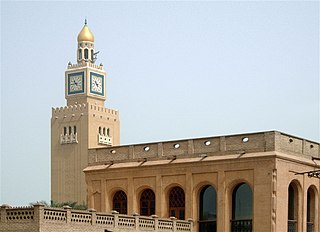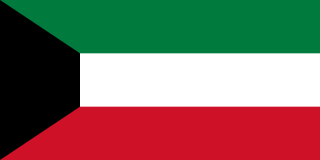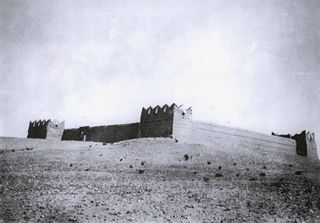Kuwait is a sovereign state in Western Asia located at the head of the Persian Gulf. The geographical region of Kuwait has been occupied by humans since antiquity, particularly due to its strategic location at the head of the Persian Gulf. In the pre-oil era, Kuwait was a regional trade port. In the modern era, Kuwait is best known for the Gulf War (1990–1991).
As a small country, local transport in Kuwait is largely road-based with one car for every 2.25 people. Bus services make up Kuwait's entire public transport network. There are seven airports in Kuwait, the largest of which and solely allocated for civil use is Kuwait International Airport. The Gulf Railway is currently under planning in Kuwait. The metro for Kuwait City is currently in the design phase. Kuwait has several maritime ports along the coast of the Persian Gulf, the largest port is Mubarak Al Kabeer Port which is currently under construction.

The Kuwait Armed Forces are the military forces of the State of Kuwait. They consist of the Kuwait Air Force, the Kuwait Army, the Kuwait Navy & the Kuwait National Guard. The governing bodies are the Kuwait Ministry of Defense, the Kuwait Ministry of Interior, and the Kuwait Fire Service Directorate. The Emir of Kuwait is the commander-in-chief of all defense forces while the Crown Prince is the deputy commander.

Kuwait City is the capital and largest city of Kuwait. Located at the heart of the country on the south shore of Kuwait Bay on the Arabian Gulf, it is the political, cultural and economic centre of the emirate, containing Kuwait's Seif Palace, government offices, and the headquarters of most Kuwaiti corporations and banks. It is one of the hottest cities in summer on earth, with average summer high temperatures over 45 °C (113 °F) for three months of the year.

Salmiya is an area in Hawalli Governorate in Kuwait.
Shuwaikh is a seaside district of Kuwait City in Kuwait. It comprises eight blocks. Shuwaikh also has an industrial area, a port, a commercial area, a healthcare area and an education area; all of which form their own census-designated districts.

Kuwait, officially the State of Kuwait, is a country in West Asia. It is situated in the northern edge of Eastern Arabia at the tip of the Persian Gulf, bordering Iraq to the north and Saudi Arabia to the south. Kuwait also shares maritime borders with Iran. Kuwait has a coastal length of approximately 500 km (311 mi). Most of the country's population reside in the urban agglomeration of the capital and largest city Kuwait City. As of 2023, Kuwait has a population of 4.82 million people of which 1.53 million are Kuwaiti citizens while the remaining 3.29 million are foreign nationals from over 100 countries.

Deira is a historically significant district within the city of Dubai, United Arab Emirates bordered by the Creek, Sharjah, and Al Awir.

This page list topics related to Kuwait.

Al Jahra is a town and city located 32 kilometres (20 mi) west of the centre of Kuwait City in Kuwait. Al Jahra is the capital of the Al Jahra Governorate of Kuwait as well as the surrounding Al Jahra District which is agriculturally based. Encyclopædia Britannica recorded the population in 1980 as 67,311. Historically, Jahra was a predominantly agricultural area. There are currently various farms in Jahra.
Shuwaikh Port is an urban industrial area within the Al Asimah Governorate in Kuwait City, Kuwait.

Sheikh Saad Al-Abdullah Al-Salim Al-Sabah was the Emir of Kuwait from 15 January 2006, succeeding Sheikh Jaber Al-Ahmad Al-Jaber Al-Sabah, until abdicating nine days later on 24 January. Prior to that he had been Prime Minister of Kuwait from 1978 to 1990.

Al-Madina Souq is the covered souq-market located at the heart of the Syrian city of Aleppo within the walled ancient part of the city. With its long and narrow alleys, al-Madina Souq is the largest covered historic market in the world, with an approximate length of 13 kilometers. It is a major trade centre for imported luxury goods, such as raw silk from Iran, spices and dyes from India and many other products. Al-Madina Souq is also home to local products such as wool, agricultural products and soap. Most of the souqs date back to the 14th century and are named after various professions and crafts, hence the wool souq, the copper souq, and so on. Aside from trading, the souq accommodated the traders and their goods in khans (caravanserais) scattered within the souq. Other types of small market-places were called caeserias (قيساريات). Caeserias are smaller than khans in size and functioned as workshops for craftsmen. Most of the khans took their names after their function and location in the souq, and are characterized by beautiful façades and entrances with fortified wooden doors.

The Sheikhdom of Kuwait was a sheikhdom during the pre-oil era. The sheikhdom became a British protectorate between 1899 and 1961 following the Anglo-Kuwaiti agreement of 1899. This agreement was made between Sheikh Mubarak Al-Sabah and the British Government in India, primarily as a defensive measure against threats from the Ottoman Empire. After 1961, the sheikdom became the state of Kuwait.
Hawally is an area in the Hawalli Governorate, located in the State of Kuwait.

The Kuwait Red Fort, or Red Palace, is a historic palace and museum that lies about 32 kilometres west of Kuwait City in Al-Jahra.

Tala'a Kebira is one of the longest and most important streets in Fes el-Bali, the old city (medina) of Fes, Morocco. The street runs roughly east to west, starting near the Bab Bou Jeloud and Bab Mahrouk gates in the west and ending at the al-Attarine Madrasa in the east, near the Qarawiyyin Mosque. It constitutes one of the main souq streets in the old city and a number of important historic monuments are built along it.

The Kissariat al-Kifah or Kissaria (القيسارية) is the historic central bazaar of Fes el-Bali, the historic old city of Fez, Morocco. It is located between the Zawiya of Moulay Idris II and the Qarawiyyin Mosque.














